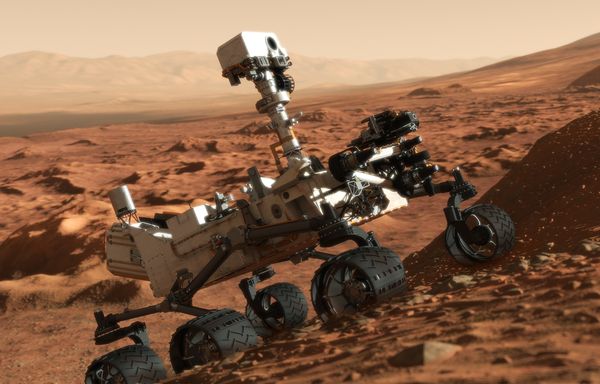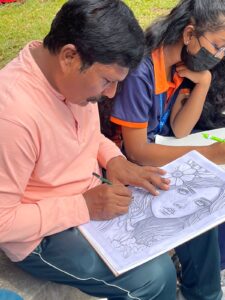NASA’S ROVER CURIOSITY LANDS ON MARS

NASA's Curiosity rover explores Mars's Gale Crater in an artist's conception.

In an ecstatic moment of triumph for outer space exploration, the National Aeronautics and Space Administration’s robotic Curiosity spacecraft on Monday successfully landed on Mars to begin its pioneering two-year hunt to find out if the red planet once hosted conditions suitable for life.
“Touchdown confirmed,” triumphant NASA engineer Allen Chen claimed in the control room as America’s most high-tech interplanetary rover survived a harrowing plunge through the Mars’ thin atmosphere to touch down on the red planet at 05.30 GMT (11.00 IST).
“We are safe on Mars,” the NASA engineers said as Curiosity started beaming live images from inside the crater where it had landed.
The US$ 2.5 billion spacecraft is the largest and most advanced ever sent to another planet. The car-size, one-tonne rover’s descent-stage retrorockets fired, guiding it in a “sky crane” manoeuvre to the surface of the Mars.
Applause erupted across the campus of the Jet Propulsion Laboratory in La Canada Flintridge and engineers inside mission control could be seen hugging and weeping with joy as it received the first photos from Curiosity rover.
Just minutes after the signal arrived that the landing had gone off successfully, Curiosity beamed back its first black-and-white thumbnail image of Mars. Soon after, a bigger image — 256 by 256 pixels large — showed up onscreen at the laboratory.
Curiosity is expected to revolutionise the understanding of Mars, gathering evidence that Mars is or was capable of fostering life, probably in microbial form.
The spacecraft is also expected to pave the way for important leaps in deep-space exploration, including bringing Martian rock or soil back to Earth for detailed analysis and, eventually, human exploration.
Scientists have found signs of water on the red planet, though it is now a dry place with a thin atmosphere, extreme winters and dust storms.
Curiosity is not equipped to search for living or fossil microorganisms but it will look for basic ingredients essential for life, including carbon, nitrogen, phosphorous, sulphur and oxygen.
Curiosity traveled nearly 570 million kilometers since it was launched in November.
NASA officials told reporters at a pre-landing news conference on Sunday that the spacecraft was functioning properly as it sped toward its target.
Curiosity carries 10 science instruments with a total mass 15 times as large as the science payloads on the Mars rovers Spirit and Opportunity. Some of the tools are the first of their kind on Mars, such as a laser-firing instrument for checking elemental composition of rocks from a distance.
The rover will use a drill and scoop at the end of its robotic arm to gather soil and powdered samples of rock interiors, then sieve and parcel out these samples into analytical laboratory instruments inside the rover.
To handle this science toolkit, Curiosity is twice as long and five times as heavy as Spirit or Opportunity. The Gale Crater landing site places the rover within driving distance of layers of the crater’s interior mountain. Observations from orbit have identified clay and sulfate minerals in the lower layers, indicating a wet history.
The landing site was 154 million miles from home and the spacecraft’s elaborate landing sequence had to be automated.
Curiosity returned its first view of Mars, a wide-angle scene of rocky ground near the front of the rover. More images are anticipated in the next several days as the mission blends observations of the landing site with activities to configure the rover for work and check the performance of its instruments and mechanisms.
“Our Curiosity is talking to us from the surface of Mars,” said MSL Project Manager Peter Theisinger of NASA’s Jet Propulsion Laboratory in Pasadena, California.
“The landing takes us past the most hazardous moments for this project, and begins a new and exciting mission to pursue its scientific objectives,” he said.
Over the first week, Curiosity is to deploy its main antenna, raise a mast containing cameras, a rock-vaporising laser and other instruments, and take its first panoramic shot of its surroundings.
NASA will spend the first month checking out Curiosity. The first drive could occur early in September. The rover would not scoop its first sample of Martian soil until mid-September at the earliest, and the first drilling into rock would occur in October or November.
Because Curiosity is powered by electricity generated from the heat of a chunk of plutonium, it could continue operating for years, perhaps decades, in exploring the 96-mile-wide crater where it has landed.




